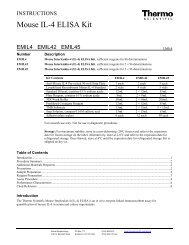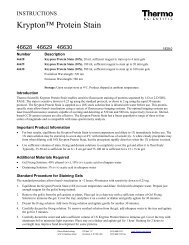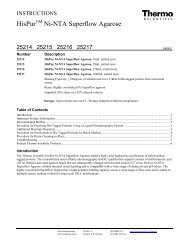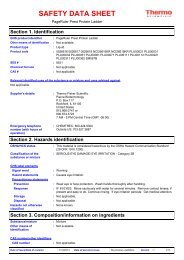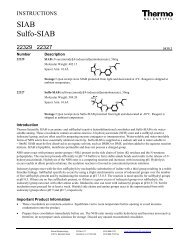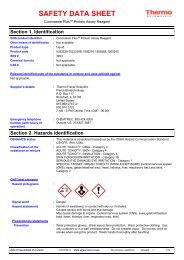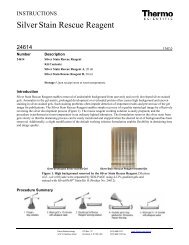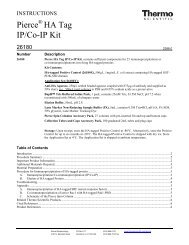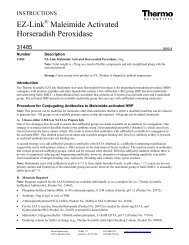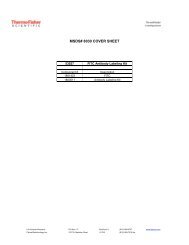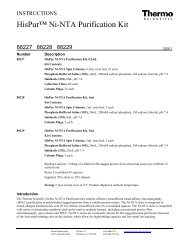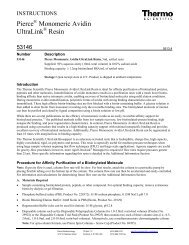Thermo Scientific Pierce Protein Assay Technical Handbook Version 2
Thermo Scientific Pierce Protein Assay Technical Handbook Version 2
Thermo Scientific Pierce Protein Assay Technical Handbook Version 2
You also want an ePaper? Increase the reach of your titles
YUMPU automatically turns print PDFs into web optimized ePapers that Google loves.
Quick <strong>Technical</strong> Summaries – <strong>Thermo</strong> <strong>Scientific</strong> <strong>Protein</strong> <strong>Assay</strong>s<br />
Working Range<br />
(sample volume)* Characteristics/Advantages Applications Disadvantages Interfering Substances<br />
<strong>Pierce</strong> ® 660nm <strong>Protein</strong> <strong>Assay</strong><br />
Standard Protocol:<br />
25-2,000µg/mL (65µL)<br />
Microplate Protocol:<br />
50-2,000µg/mL (10µL)<br />
Compatible with reducing agents, chelating<br />
agents and detergents<br />
Faster and easier to perform than BCA or<br />
Coomassie (Bradford) <strong>Assay</strong>s<br />
Excellent linearity of color development within<br />
the detection range<br />
Less protein-to-protein variability than the<br />
Coomassie (Bradford) <strong>Assay</strong><br />
Ideal for measuring total<br />
protein concentration in<br />
samples containing<br />
both reducing agents<br />
and detergents<br />
Used for quick, yet accurate<br />
estimation of protein<br />
Use reagent with IDCR<br />
(Ionic Detergent<br />
Compatibility Reagent)<br />
with samples containing<br />
ionic detergents like SDS<br />
Greater protein-to-protein<br />
variability than the<br />
BCA <strong>Assay</strong><br />
High levels of ionic<br />
detergents require the<br />
addition of the Ionic<br />
Detergent Compatibility<br />
Reagent (IDCR).<br />
Reaches a stable end point<br />
Compatible with Laemmli sample buffer<br />
containing bromophenol blue when using<br />
Compatibility Buffer<br />
The BCA <strong>Protein</strong> <strong>Assay</strong> - Reducing Agent Compatible<br />
Standard Protocol:<br />
125-2,000µg/mL (25µL)<br />
Microplate Protocol:<br />
125-2,000µg/mL (9µL)<br />
Compatible with up to 5mM DTT, 35mM<br />
2-Mercaptoethanol or 10mM TCEP<br />
No protein precipitation involved<br />
Sample volume only 9µL (microplate protocol)<br />
Compatible with most detergents<br />
Significantly less (14-23%) protein:protein<br />
variation than Bradford-based methods<br />
Allows the use of the<br />
superior BCA <strong>Assay</strong> in<br />
situations in which it is<br />
normally unable to be read<br />
No precipitation step<br />
means no worries about<br />
difficult-to-solubilize proteins<br />
Requires heating for<br />
color development<br />
Compatible with all reducing<br />
agents and detergents found<br />
at concentrations routinely<br />
used in protein sample buffers<br />
The BCA <strong>Protein</strong> <strong>Assay</strong><br />
Standard Protocol:<br />
20-2,000µg/mL (50µL)<br />
Enhanced Standard<br />
Protocol: 5-250µg/mL<br />
(50µL)<br />
Microplate Protocol:<br />
20-2,000µg/mL (25µL)<br />
Two stable reagents used to make one<br />
working reagent<br />
Working reagent stable for one week at<br />
room temperature<br />
Compatible with detergents<br />
Simple, easy to perform<br />
Less protein:protein variation than Coomassie<br />
dye methods<br />
Works with peptides (three amino acids<br />
or larger)<br />
Adaptable for use with<br />
microplates<br />
Determine the amount of<br />
IgG coated on plates<br />
Measure the amount of<br />
protein covalently bound<br />
to affinity supports<br />
Determine copper levels<br />
using a reagent formulated<br />
with BCA Reagent A 4<br />
Not compatible with<br />
thiols/reducing agents<br />
Requires heating for<br />
color development<br />
Not a true end-point assay<br />
Reducing sugars and<br />
reducing agents<br />
Thiols<br />
Copper chelating agents<br />
Ascorbic acid and uric acid<br />
Tyrosine, cysteine and<br />
tryptophan<br />
50mM Imidazole, 0.1M Tris,<br />
1.0M glycine<br />
Flexible incubation protocols allow customization<br />
of reagent sensitivity and working range<br />
The Micro BCA <strong>Protein</strong> <strong>Assay</strong><br />
Standard Protocol:<br />
60°C for 60 minutes<br />
0.5-20µg/mL (0.5mL)<br />
Microplate Protocol:<br />
37°C for 120 minutes<br />
2-40µg/mL (150µL)<br />
Three stable reagents used to make one<br />
working reagent<br />
Working reagent stable for 24 hours at<br />
room temperature<br />
Compatible with most detergents<br />
Simple, easy to perform<br />
Less protein:protein variation than BCA,<br />
Coomassie dye or Lowry Methods<br />
Works with peptides (three amino acids<br />
or larger)<br />
Linear color response to increasing<br />
protein concentration<br />
Suitable for determining<br />
protein concentration<br />
in very dilute aqueous<br />
solutions<br />
Adaptable for use with<br />
microplates 1<br />
More substances interfere<br />
at lower concentrations<br />
than with BCA <strong>Assay</strong><br />
because the sample<br />
volume-to-reagent volume<br />
ration is 1:1<br />
60°C water bath is needed<br />
Reducing sugars and<br />
reducing agents<br />
Thiols<br />
Copper chelating agents<br />
Ascorbic acid and uric acid<br />
Tyrosine, cysteine and<br />
tryptophan<br />
50mM Imidazole, 0.1M Tris,<br />
1.0M glycine<br />
* Sample volume per 1mL total assay volume for measurement in 1cm cuvette (Standard Protocol). Sample volume per 200-300µL total volume for measurement in 96-well microplate.<br />
To order, call 800-874-3723 or 815-968-0747. Outside the United States, contact your local branch office or distributor.<br />
1



